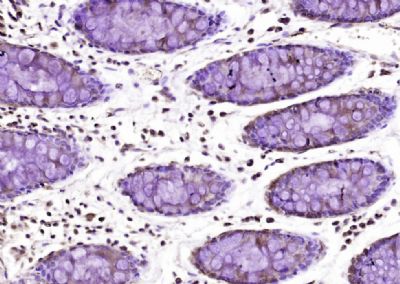产品货号 : mlR21823
英文名称 : OSMR
中文名称 : 抑瘤素M受体抗体
别 名 : Oncostatin M receptor; Oncostatin M specific receptor subunit beta; Interleukin-31 receptor subunit beta; IL-31 receptor subunit beta; IL-31R subunit beta; IL-31R-beta; IL-31RB; Oncostatin-M-specific receptor, beta; OSMRB; MGC140467; MGC150626; MGC150627; MGC75127.
研究领域 : 肿瘤 细胞生物 免疫学 转录调节因子
抗体来源 : Rabbit
克隆类型 : Polyclonal
交叉反应 : Human,
产品应用 : ELISA=1:500-1000 IHC-P=1:400-800 IHC-F=1:400-800 ICC=1:100-500 IF=1:100-500 (石蜡切片需做抗原修复)
not yet tested in other applications.
optimal dilutions/concentrations should be determined by the end user.
分 子 量 : 111kDa
细胞定位 : 细胞膜
性 状 : Lyophilized or Liquid
浓 度 : 1mg/ml
免 疫 原 : KLH conjugated synthetic peptide derived from human OSMR:571-670/979 <Extracellular>
亚 型 : IgG
纯化方法 : affinity purified by Protein A
储 存 液 : 0.01M TBS(pH7.4) with 1% BSA, 0.03% Proclin300 and 50% Glycerol.
保存条件 : Store at -20 °C for one year. Avoid repeated freeze/thaw cycles. The lyophilized antibody is stable at room temperature for at least one month and for greater than a year when kept at -20°C. When reconstituted in sterile pH 7.4 0.01M PBS or diluent of antibody the antibody is stable for at least two weeks at 2-4 °C.
PubMed : PubMed
产品介绍 : Oncostatin M is a member of the IL6 family of cytokines. Functional receptors for IL6 family cytokines are multisubunit complexes involving members of the hematopoietin receptor superfamily. Many IL6 cytokines utilize gp130 as a common receptor subunit. OSM binds to the gp130 receptor subunit and, in association with the leukemia inhibitory factor receptor, induces a proliferative response in permissive cells. OSMR is an alternative subunit (for an OSM receptor complex (a heterodimer of gp130 and OSMR) that is activated by OSM but not by LIF.
Function:
Associates with IL31RA to form the IL31 receptor. Binds IL31 to activate STAT3 and possibly STAT1 and STAT5. Capable of transducing OSM-specific signaling events.
Subcellular Location:
Membrane.
Tissue Specificity:
Expressed at relatively high levels in all neural cells as well as fibroblast, epithelial and a variety of tumor cell lines.
DISEASE:
Amyloidosis, primary localized cutaneous, 1 (PLCA1) [MIM:105250]: A primary amyloidosis characterized by localized cutaneous amyloid deposition. This condition usually presents with itching (especially on the lower legs) and visible changes of skin hyperpigmentation and thickening that may be exacerbated by chronic scratching and rubbing. Primary localized cutaneous amyloidosis is often divided into macular and lichen subtypes although many affected individuals often show both variants coexisting. Lichen amyloidosis characteristically presents as a pruritic eruption of grouped hyperkeratotic papules with a predilection for the shins, calves, ankles and dorsa of feet and thighs. Papules may coalesce to form hyperkeratotic plaques that can resemble lichen planus, lichen simplex or nodular prurigo. Macular amyloidosis is characterized by small pigmented macules that may merge to produce macular hyperpigmentation, sometimes with a reticulate or rippled pattern. In macular and lichen amyloidosis, amyloid is deposited in the papillary dermis in association with grouped colloid bodies, thought to represent degenerate basal keratinocytes. The amyloid deposits probably reflect a combination of degenerate keratin filaments, serum amyloid P component, and deposition of immunoglobulins. Note=The disease is caused by mutations affecting the gene represented in this entry.
Similarity:
Belongs to the type I cytokine receptor family. Type 2 subfamily.
Contains 4 fibronectin type-III domains.
SWISS:
Q99650
Gene ID:
9180
Important Note:
This product as supplied is intended for research use only, not for use in human, therapeutic or diagnostic applications.
产品图片












